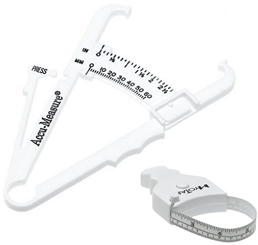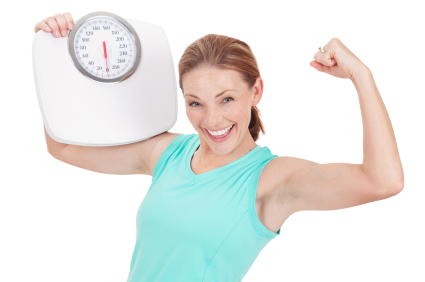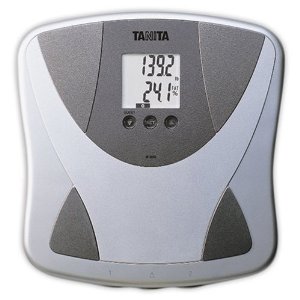 When you’re lifting weights or doing any physical exercise, it’s important to keep a record of your bodyweight and body fat percentage in order to track your progress.
When you’re lifting weights or doing any physical exercise, it’s important to keep a record of your bodyweight and body fat percentage in order to track your progress.
Having a clear record of your body fat percentage is important because a lot of the time when people start training they notice that their overall bodyweight does not change on the scales, despite clear improvements in fitness and health. This can be explained by the fact that body fat can decrease and muscle mass can increase simultaneously. Increases in muscle mass adds weight on the scales of course.
So in order to get a true picture of your progress, it’s essential to keep track of your body fat percentage, arguably your body fat percentage is more important to track than your overall bodyweight.
There are a number of different tools available to measure your body fat. I will discuss them in this article.
Skin fold calipers
If you want accurate results, skin fold calipers are probably the most cost effective way to measure your body fat.
You take measurements of skin folds from various parts of your body (stomach, arms, thighs, hips back) and measure it using the calipers. In order to get a consistent read, the calipers are pressure sensitive. You simply press until the calipers go “click” and then you release and record the measurements.
This is quite accurate, but the downside is that there are quite a lot of math involved and you need someone else to take some of the measurements for you, as it’s impossible to take measurements on your arm or your back yourself.
 |
AccuMeasure Caliper and MyoTapeI’ve used the accu-measure calipers before, they’re cheap and effective. The pressure sensitive “click” mean you won’t get duped into cheating by squeezing harder to get more flattering measurements. It has a sliding marker which will keep a mark on the reading as well. Cheapest location: amazon |
Body fat scales
 Bodyfat scales are by far the easiest and cost effective way to measure your bodyfat for the long term. They work by sending a completely harmless current through one side of your body to the other (e.g. left leg to right leg).
Bodyfat scales are by far the easiest and cost effective way to measure your bodyfat for the long term. They work by sending a completely harmless current through one side of your body to the other (e.g. left leg to right leg).
You simply turn on the scale, wait for the scale to reset to 0.0 and then step up and get your reading. In 10 seconds you’ve got your reading.
The only downside with body fat scales is that the body fat % can vary quite a lot depending on your hydration levels. The less hydrated you are the worse readings you will get. So if you measure yourself first thing in the morning, your reading can be +2% your actual body fat %. The best way to work around that is to measure your body fat in the same time each day. E.g. Measure yourself 6pm in the afternoon.
Having said that, I still prefer them over the calipers because they’re easy to operate. Remember the goal isn’t to get a scientifically accurate reading. The goal is to track your progress. If the body fat scale is giving you a consistent +.5% reading. That’s fine, because you should be more interested in the weekly changes, rather than the number itself.
A good body fat scale will last you years. I’ve had my Omron HBF-514C for almost 3 years now, since it first came out. So if you’re buying one, spend carefully as it’s a long term investment. Just don’t get the glass ones and you should be fine.
NOTE: Do not use a body fat scale if you have medical implants, such as a pacemaker or an artificial limb. Breast implants can distort your body fat % a little, but distortions are slight and acceptable.
 |
Omron HBF-514CThis is great for gadget lovers like myself, because it looks very advanced and has features to boot. The Omron HBF-514C sends pulses through your arms and legs so you get a more accurate reading. This is important because some people are top heavy or bottom heavy so the “leg only” body fat scales can be a bit off. I also take measurements with calipers from time to time, and have found that the readings between the calipers and bodyfat scales are pretty similar. Overall the Omron is excellent value for what is available at the $60 price bracket. Cheapest location: amazon |
 |
Tanita BF680WTanita have been making bodyfat scales for years, probably before everyone else, my buddy Allen uses this in his gym when measuring clients and swears by it. This has a cool feature where it shows your required calorie consumption to maintain your physique. This is a nice overview but there are better more scientific diets out there which give you a better idea. Cheapest location: amazon |
DEXA scan
DEXA scans are probably the most accurate and fool proof way to measure body fat. But it can be cost prohibitive, costing anything from £200 ($300USD) upwards for a single DEXA scan. Though I did get a scan for free after joining an expensive health spa back into 2008.
As you can imagine DEXA scans are great to do once in a while, but attempting to do this every week to track your progress is far too expensive.


Why should someone who has breast implants NOT use a body fat scale? I have tried to research this but have not found any further information other than your one sentence about people with any kind of implants should not use one. Can you direct me to any more information on this? Thanks, Elizabeth
Hi, I should clarify that using body fat scales if you have breast implants is NOT dangerous. But it’s undesirable if you want to get accurate reading. Because the implants are bad conductors therefore will report higher body fat than actual.
Though for our sake, we’re not interested in scientifically accurate results, we just want to have a rough idea on increases or decreases in body fat levels so you can use them. I have updated the post accordingly.
Just wanted to say thanks for posting this! I love the reminder to pay more attention to how you look and feel than the number on the scale. I clicked a link to see what my “healthy” BMI range is for my height (about 5’7″) and it goes all the way down to 118 on the lower end! I can’t imagine that looking healthy at all! Anyway, I’m going to look into buying one of these scales, thanks for the suggestions!
Hi thanks for all your very informative emails and posts. They have been a great help to my training.
I however am struggling to lose body fat. I exercise 6 times a week, combination of kettlebells, spin, running, tae bo and boxfit. I am 5ft 4.5. 138lbs. 36 years old. I had my 3rd baby just over a year ago and am really struggling to get to the shape I want. I’ve tried every ‘diet’. Just feel I’m hitting a brick wall….Can u give me any advice. Feel free to email me. Many thanks Jacquie 🙂
Thanks for this, I seem to forget that when getting on the scale every day and not seeing it move. I will do some checking into these scales to see which one works best for me. Thanks for the reminder!